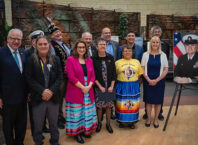Photos by Jon Lurie
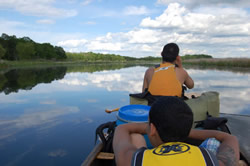 In June, two Dakota youth from Minneapolis participated in a Healthy Nations canoe trip down the Wakan Wakpa (Sacred River), also known as the Rum River. The canoe trip, part of a larger effort to help Native people reclaim their tribal legacy, exposed serious problems with the Minnesota Department of Natural Resources’ maintenance of the river.
In June, two Dakota youth from Minneapolis participated in a Healthy Nations canoe trip down the Wakan Wakpa (Sacred River), also known as the Rum River. The canoe trip, part of a larger effort to help Native people reclaim their tribal legacy, exposed serious problems with the Minnesota Department of Natural Resources’ maintenance of the river.
Native youth Ches Lorenzi and Joe Deala, and Healthy Nations’ Active Lifestyles Facilitator Jon Lurie set out on a165-mile canoe trip from Mde Wakan (Spirit Lake), or Lake Mille Lacs, to Minneapolis. The expedition was to both commemorate and renew important aspects of Dakota culture.
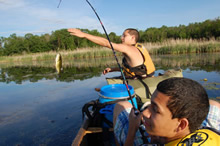 LaPointe believes the river’s name is important. “Rum is a
LaPointe believes the river’s name is important. “Rum is a
pollutant, but the river is not a poison,” he said. “It is a holy
river that contributed to generations of successful tribal communities.”
Two
years ago, Healthy Nations looked at historic practices and realized
everything the ancestors did contributed great health to their people.
“We thought such activity shouldn’t be relegated to history, not when
all our people did and all the elements they utilized are still here
today,” LaPointe said. “The activities are part of our future, not just
our history.”
Healthy Nations hopes Native children and families
will recover this knowledge and understanding by visiting the same
routes as their ancestors. The June canoe trip down Wakan Wakpa is part
of this overall effort.
The trip began in a beautiful setting.
Lurie said both the weather and Spirit Lake were gorgeous. Deala and
Lorenzi placed tobacco in the mouth of the river to ask for permission
and guidance from relatives in the spirit world. Then the group paddled
from the headwaters at the southwest section of the lake.
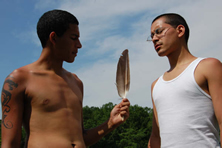 The
The
first day, they paddled through three lakes. The men saw a variety of
wildlife and caught several fish. They observed the river’s flow
through the lakes and the increasingly rich wetlands. The third lake
was dense with healthy green plants.
Lurie said he could see why
the river is sacred. As it progresses through the lakes and their
wetlands, the water is filtered and purified even as it feeds the plant
and animal life along the waterways.
“Minneapolis gets its clean water from that river,” Lurie said. “It is an incredible natural system.”
On
the second day the river grew shallow and they often had to walk
through the water, guiding the canoe to avoid running aground. Under a
hot sun, they covered 32 miles in ten hours and were exhausted when
they reached Milaca. Lurie said they were concerned they would not be
able to paddle if the river remained shallow.
“The significance of the trip,” said LeMoine LaPointe, Director of
Healthy Nations at Minneapolis American Indian Center, “is to begin
scouting areas that we have historically and culturally utilized for
health and wellness.”
LaPointe says the Wakan Wakpa brought
success and health to the Dakota community when it lived around Mde
Wakan. The Lakota people also utilized Wakan Wakpa to reach the
Mississippi River.
The third day
brought another concern: log jams. For 25 miles, the expedition had to
carry the canoe over, or portage around, fallen trees and logs that had
filled with both natural and human-made debris. At one point, they came
across four barrels that appeared to contain chemical waste. They also
saw old boats gnarled into trees in the middle of the river.
Mosquitoes
added to their troubles. “Each time we came to a pile of trees, we
disturbed the mosquitoes that had been breeding in the slow water,”
Lurie said. “There wasn’t an exposed part of our bodies that wasn’t
covered in bites. It looked like we each had a rash.”
That night
they camped near Princeton, but the state campsite they planned to use
was not cleared. In some places the grass reached their necks, and
mosquitoes and tics were everywhere. So the group left the riverbank
and carried their equipment a quarter of a mile to get around a log jam
and reach a private campground.
The next day brought a clean
river through Princeton – no log jams and a clear sandy bottom. But 20
minutes outside of town, log jams reappeared every five minutes. The
canoers only made 24 miles and were falling behind schedule. The men
decided they had experienced enough hardship on the un-navigable river.
They stopped at the next town and called for assistance. Support from
Healthy Nations picked them up and they drove back to Minneapolis.
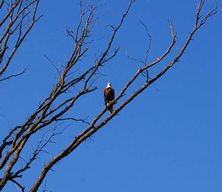 Deala,
Deala,
who participates in many Healthy Nations canoe trips and often serves
as a staff leader, was disappointed. “I thought of it as a trip where
we could reclaim a few things,” he said. “I was shocked by the river.
It’s not taken care of. The state of Minnesota claims it as a canoe
route. But if the state sees it as an asset, they are not taking care
of their asset. It was pretty disturbing.”
Lurie has facilitated
cane trips on the Kettle and St. Croix Rivers and kicked off the
Healthy Nations Outdoor Program with a 2006 canoe trip with Deala from
the Red and Hayes Rivers all the way to Hudson Bay. He was dismayed at
the current condition of Wakan Wakpa.
“Although the state
promotes the river as an official canoe route, the river is clearly not
maintained,” Lurie said. “No state campsites we saw were maintained
either. We were able to paddle in some areas, but the river has been
neglected and is not suitable for recreation or travel.”
“The
river was taken from the original caregivers,” Deala said. “The task of
upkeep and maintenance passed to the state, but I don’t think they’re
doing a good job.”
Deala believes the trip was the right thing to
do, especially because he and Lorenzi received a good sign. When they
were on the river, they heard something big coming off the trees. Deala
turned to see an eagle swoop and dive toward the river before flying
high and away.
“It left an eagle feather in the water,” he
said. “It floated toward us. We picked it up, and it felt like a sign
that we were supposed to be there.”
Lurie and LaPointe appreciate
the young men’s efforts. “It’s hard to get people to volunteer for what
we went through,” Lurie said. “That’s why I asked Joe and Ches. I knew
they had experience and could do the trip and give it all they had.”
“They
met all I hoped for with this trip,” said LaPointe. “They were a
scouting party for the future. We as a people are always looking ahead.
History is important, but Native culture is about vision, about
standing and seeing all there is to see.”
LaPointe hopes more
Native people will become involved in the Outdoor Program. There are
novice canoe groups on the lakes in Minneapolis for girls, women, and
fathers, as well as youth activities throughout the seasons, including
hiking, skiing, and skating.
“We sometimes have elders on the
outdoor trips to share indigenous knowledge,” LaPointe said. “I want
the youth to know this knowledge belongs to them. It’s older than the
Greeks and other people in their textbooks. And the challenges they
face on the trips prepare them for life, for making decisions,
negotiating problems, and serving their community.”
For more
information on participating in the Outdoor Program with Healthy
Nations, contact Jon Lurie at 612-879-1736 or at: jlurie@maicnet.org.





